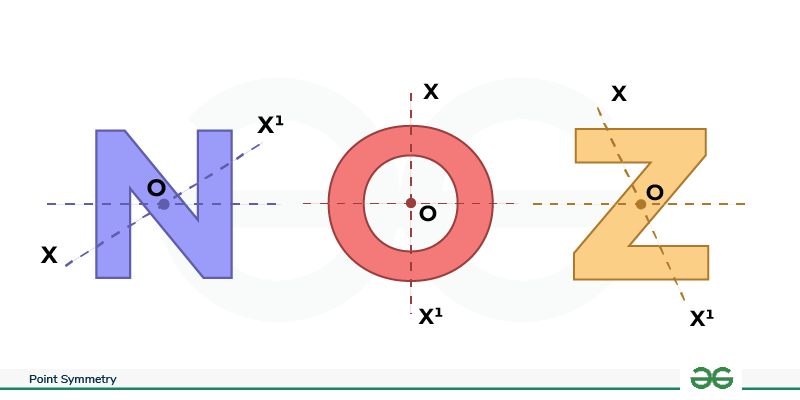
|
|
Point Symmetry, or Origin Symmetry, or Central Symmetry is a type of symmetry where an object or shape looks the same when rotated 180° (a half-turn) around a central point. In this article, we will discuss Point Symmetry in detail including its definition, examples, as well as some real-life examples in nature as well. Table of Content
What is Symmetry?Symmetry means when you can split a shape or thing into two parts that look the same. In a symmetrical thing, one side is like a mirror image of the other. The imaginary line you can fold along to make those matching halves is called the line of symmetry. What is Point Symmetry?Point symmetry is when any object or anything looks the same after turning it 180° around a central point or we can say, from a certain point when an object is flipped at 180° it gives an equal or identical shape. It’s like a spinning toy that stops looking different no matter how you turn it. The center is the point where it stays unchanged, creating a balanced, matching shape on both sides. To check whether an image creates point symmetry or not, two conditions should be fulfilled:
Definition of Point SymmetryPoint symmetry, also known as central symmetry, is a geometric property exhibited by certain shapes or figures.
In simpler terms, if the shape looks unchanged after a half-turn (180-degree rotation) around a specific point, it possesses point symmetry. How to Identify Point Symmetry?To identify point symmetry, we can use following steps.
Point Symmetry in Geometric ShapesIn various geometric shapes such as square, rectangle, parallelogram, circle, star, etc., we can observe the point symmetry which is discussed as follows: Point Symmetry of Square/Rectangle
Read More about Square and Rectangle. Point Symmetry of Parallelogram
Point Symmetry of a Circle
Point Symmetry of a Star
Point Symmetry in LettersWhen you have point symmetry in the alphabet, it means that if you draw a line through a certain point, the parts on either side of that point are the same distance from it. In English letters, you can find point symmetry. Take the letter O, for example. It has a center point, and the parts on opposite sides are the same but facing different ways. Uppercase letters like C, D, H, I, N, O, X, and Z also have point symmetry. If you draw a line from the middle of C, D, H, I, O, or X, both the upper and lower parts will be the same length. So, these letters have both point and line symmetry.
Point Vs Reflection SymmetryThe key differences between point symmetry and reflection symmetry are:
Symmetry in Visual ArtsIn visual arts, symmetry is a fundamental concept employed to create balance and harmony in compositions. Artists use symmetrical arrangements, where one side mirrors the other, to instill a sense of order and aesthetic appeal. Symmetry can be found in various art forms, from paintings and sculptures to graphic designs. It serves as a guiding principle for creating visually pleasing and impactful pieces by ensuring a harmonious distribution of elements. Architectural Designs and PatternsArchitectural designs often incorporate symmetry to achieve a sense of equilibrium and beauty in structures. Symmetrical elements in buildings, such as matching facades or balanced layouts, contribute to a visually cohesive and pleasing architectural aesthetic. Patterns, whether in tiling, ornamentation, or structural elements, frequently exhibit symmetry to enhance the overall design. This use of symmetry in architecture transcends cultural and historical contexts, representing a timeless approach to creating structures that are not only functional but also visually captivating. Point Symmetry in NatureIn nature, point symmetry is not as common as other types of symmetry, like bilateral symmetry, but it can still be observed in various forms:
Sample Example on Point SymmetryExample 1: State whether the following statement is true or false: “Every equilateral triangle exhibits point symmetry.” Solution:
Example 2: A figure has a point symmetry at the origin. If point B(-2, 5) is part of the figure, find the coordinates of its image point. Solution:
Practice Problems on Point SymmetryProblem 1: Analyze the following set of points: A(1, 4), B(4, 1), C(-1, -4), and D(-4, -1). Determine if these points form a figure with point symmetry, and if so, identify the point of symmetry. Problem 2: Identify whether the letter “X” exhibits point symmetry. If yes, describe the point of symmetry; if not, explain why. Problem 3: Draw a simple figure with point symmetry and describe the coordinates of the point of symmetry. Problem 4: Given a geometric pattern, analyze whether it displays point symmetry. Provide details on any symmetrical elements. Point Symmetry: FAQsDefine Point Symmetry.
What is Point Symmetry in Real Life?
How do you Draw Point Symmetry?
What is the Difference between Point Symmetry and Rotational Symmetry?
What is Point Symmetry in Alphabets?
What are the 4 Types of Symmetry?
How to Test for Point Symmetry?
|
|||||||||||||||||||||||||||
Reffered: https://www.geeksforgeeks.org
| Class 7 |
Type: | Geek |
Category: | Coding |
Sub Category: | Tutorial |
Uploaded by: | Admin |
Views: | 14 |



